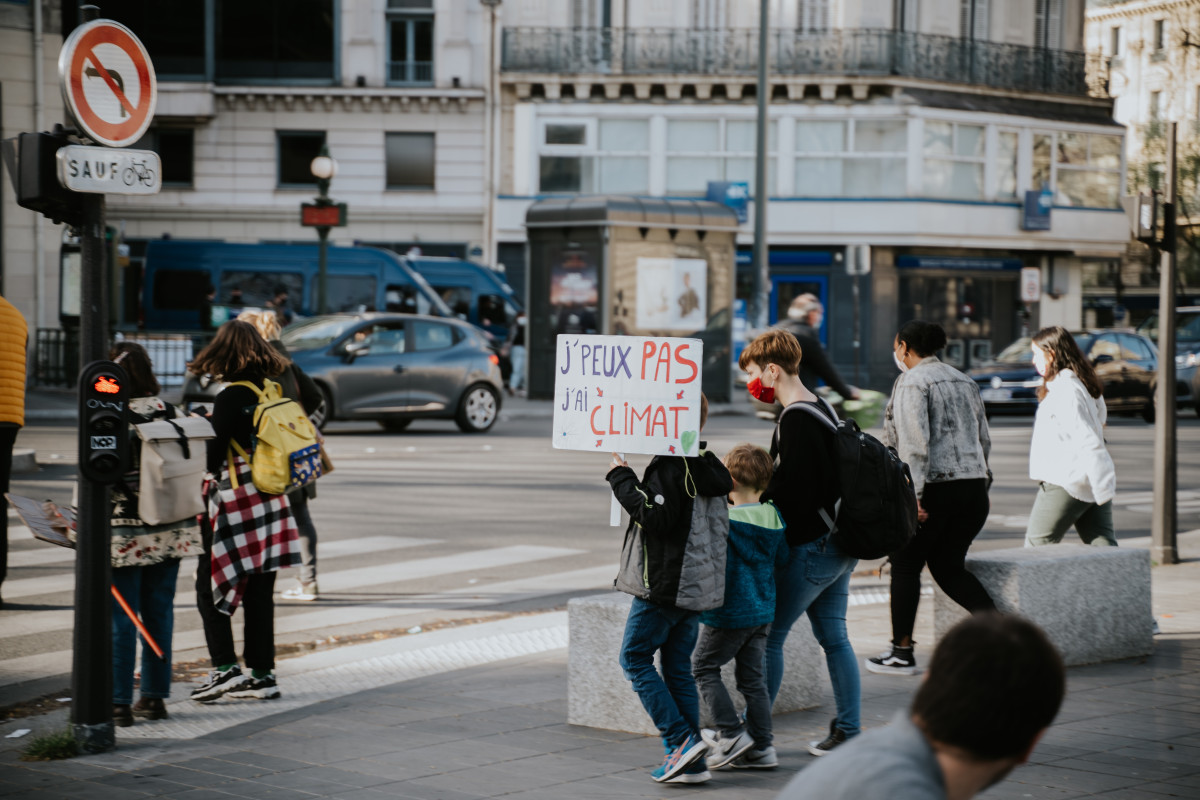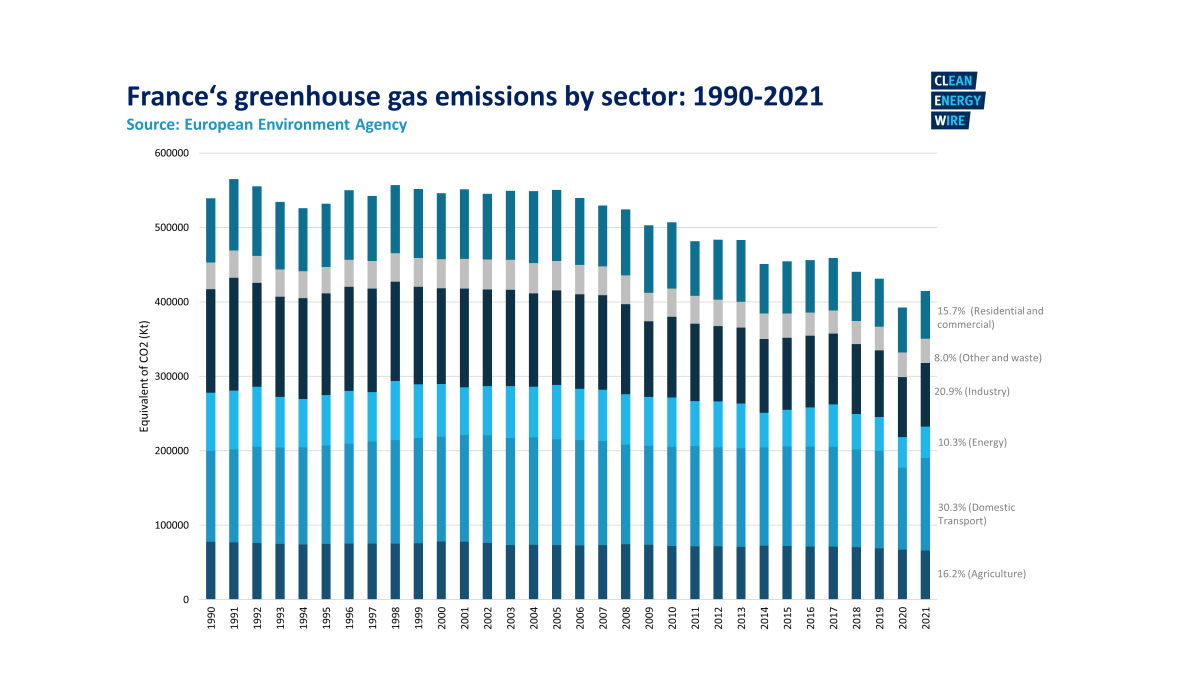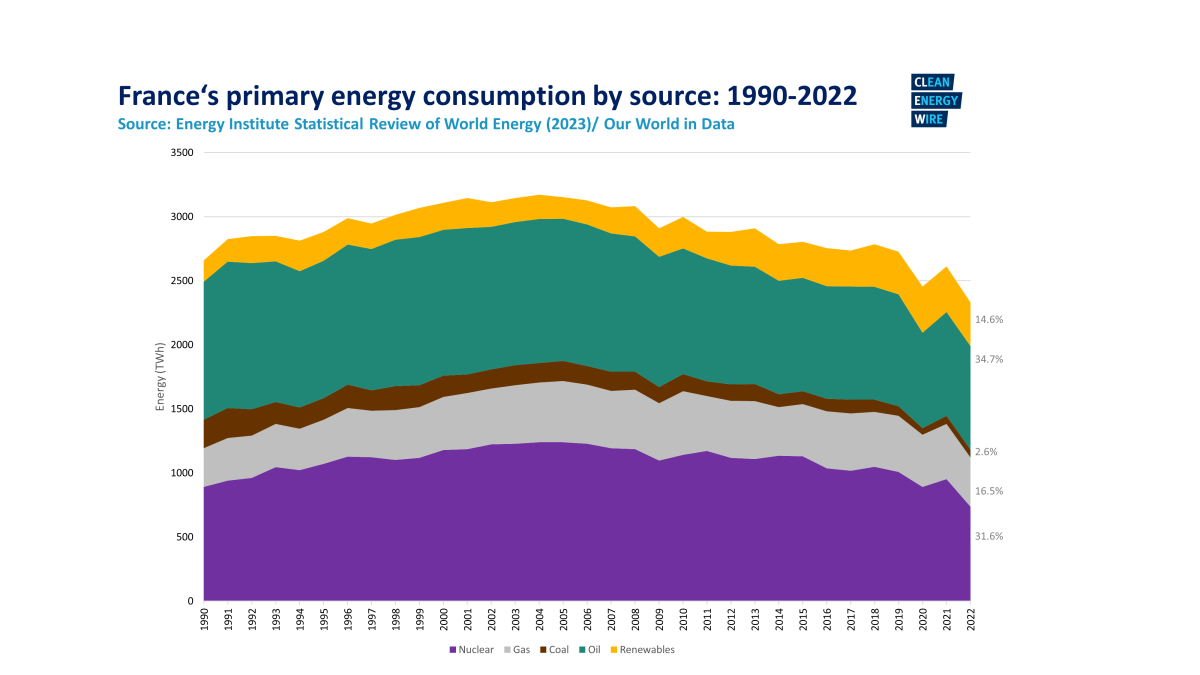CLEW Guide – France caught between national and European energy ambitions
With its “CLEW Guide” series, the Clean Energy Wire newsroom and contributors from across Europe are providing journalists with a bird's-eye view of the climate-friendly transition from key countries and the bloc as a whole. You can also sign up to the weekly newsletter here to receive our "Dispatch from..." – weekly updates from Germany, France, Italy, Croatia, Poland and the EU on the need-to-know about the continent’s move to climate neutrality.
Content:
*** Also see this full dossier exploring Franco-German approaches to climate and energy policy and effects on the EU.***
Key background
- France bets heavily on nuclear power in its bid to become climate neutral by 2050. It has the world’s highest share of nuclear power in its grid, with about 65 percent of its electricity generated by the country’s 56 operable reactors, and it has plans to build between 6 to 14 additional nuclear power stations.
- France’s emissions per capita are relatively low compared with many other European countries, which continue to rely more heavily on fossil fuels for electricity production. France’s greenhouse gas emissions are expected to fall by 0.8 percent in 2025 compared to the previous year (1.8% fall in 2024), according to Citepa, a non-profit organisation specialising in atmospheric pollution and the body responsible for monitoring this data. In 2024, France was the EU’s second biggest polluter, behind Germany.
- France’s wind and solar power deployment pace is comparatively slow. In 2020 and 2022, the country missed the EU’s binding target and refused to pay the corresponding fine, instead lobbying to have nuclear classified as a low-carbon source, alongside renewables, in EU-wide targets. While left-wing parties generally push for rolling out renewables, the right is calling for an increase in nuclear ambitions.
-
At a time when it needs to decide major long-term energy strategies, the unprecedented political crisis continues ever since president Emmanuel Macron called a snap election in 2024. The country has had four different prime ministers appointed (including two nominations for the most recent one, Sebastien Lecornu) and seven governments. The far-right Rassemblement National party is still close to gaining power. If the party were to succeed in the 2027 presidential election, it would have far-reaching consequences for energy policy — not only in France, but across Europe.
- Following a series of heatwaves, floods, wildfires and droughts, France rebooted its climate change adaptation strategy to include proposals for adaptation to 4 degrees Celsius of warming, in a sign that the government is ready to prepare for the worst.
Major transition stories
- Nuclear power – The energy crisis during the Ukraine war and ongoing problems at its fleet of nuclear power plants pushed France to move ahead with legislation to quicken the deployment of renewables, while also accelerating the construction of new nuclear power plants. It now plans to build at least 6 reactors, with the possibility of increasing that number to 14. But climate change creates challenges for the industry, as air and river temperatures during heatwaves increasingly impair cooling systems, resulting in shutdowns. Safety authorities and auditors push state-owned energy supplier EDF to better adapt to global warming.
- Agricultural boost – Faced with pressure from farmers voicing their anger over difficult working conditions and low incomes, the French government has been looking to loosen green farming requirements. France has the EU’s largest agricultural sector.
- Grid stability – The fallout from the massive blackout that hit Spain, Portugal and parts of southern France raised concerns over grid stability and negative power prices, and prompted calls from experts and politicians to slow or even stop the rollout of renewables, even though wind and solar did not cause the failure.
- Climate activism – Human rights NGO Amnesty International has denounced “the repression of environmental and climate activists” in France, and voiced concerns over “growing attacks” against freedom of expression and the right to demonstrate, arguing these have “dissuasive” effects on climate action. Climate protests in France have often been more radical than in neighbouring countries, for example the violent protests against vast irrigation reservoirs (megabasins) in 2023.
- Energy plans –Major roadmaps for France’s energy and climate strategy were expected in 2024, but were delayed. Attention has now shifted to its energy plan for the next 10 years, which was submitted to public consultation. It was supposed to be adopted earlier this year.
- Climate investments – The country’s climate investments are insufficient, according to the Institute for Climate Economics. After rising steadily since 2020, public and private climate-related investments in 2024 dropped by 5 percent from 2023 levels, resulting in 102.2 billion euros spent in France on climate-related projects. The decrease was particularly marked in the real estate, renewable energies and transport sectors.
- Hydroelectric rules – The government is considering to change the rules governing concessions for hydroelectricity, as part of efforts to end a longstanding feud with the EU. In 2015 and 2019, the European Commission launched two infringement procedures against France for non-compliance with competition rules, mainly criticising the dominant position of state-owned utility EDF.
- Energy sufficiency – Following on from national energy saving efforts during the 20222 winter, the government proposed an energy efficiency plan for all sectors to ensure further savings. Measures include higher penalties for high-emitting vehicles, and limiting temperatures in buildings. A new strategy was set to be presented in 2024, but the dissolution of parliament disrupted the political agenda.
- Sustainable finance – In 2023, French legislators backed away from compulsory “Say on Climate” measures that were part of the government’s green industry bill and would have made France the first country worldwide to require listed companies to consult their shareholders on climate strategies.
Sector overview
Energy
- The energy sector accounts for about 9 percent of the country’s total GHG emissions.
-
Renewables development stalled in 2024. France managed to reach its target of generating 23 percent of its gross final energy consumption from renewable sources four years behind schedule.
- In 2024, 94 percent of France’s electricity was generated by low-carbon sources including nuclear, above the global average of 41 percent. By far the largest source of climate-friendly electricity is nuclear energy, with a share of 68 percent, followed by wind and solar power at 12 percent, which is below the global average. As part of efforts to reach carbon neutrality by 2050, the country aims for 35 percent of renewable electricity by 2030, which falls short of the International Energy Agency’s net-zero emissions scenario. It also targets 41.3 percent renewables in final energy consumption in 2030, as stated in its National Energy and Climate Plan. The European Commission asked the French government to raise its ambition to at least 44 percent.
- You can find electricity production by sector in real time here.
- The country plans to phase out fossil fuel electricity generation, from a current share of 6 percent, starting with the closure of its two remaining coal-fired power plants by 2027. But the government, which is elaborating its multiannual energy plan, is now pushing a bill that would allow the conversion into gas power stations instead. This concerns the Émile Huchet coal plant, while state-owned utility EDF has confirmed the closure of the Cordemais plant. Meanwhile, the government appears to have removed a pledge to no longer build fossil fuel-fired power plants, and revised ambitions for solar power deployment downwards.
- In efforts to increase carbon-free electricity generation to at least 640 terawatt-hours (TWh) by 2035 from 390 TWh in 2022, the government is set to present the following objectives: 75 to 100 gigawatts (GW) of solar photovoltaic power, up from 16 GW in 2022; 40 to 45 GW of onshore wind and 18 GW of offshore wind, compared with 21 GW and 0.6 GW in 2022, respectively; 29 GW of hydroelectricity, up from 26 GW; 50 to 85 GW of biogas in 2035 against 17.7 GW in 2022; and finally, 330 to 419 TWh for renewable and recovered heating and cooling, a hike from 172 TWh in 2022. This translates into a reduction in national energy consumption of 30 percent by 2030 and 50 percent by 2050 from 2021 levels, for a total final energy consumption of 1,243 TWh in 2030 and around 1,100 TWh in 2035.
- Numerous plant shutdowns sent France’s nuclear electricity output to a 33-year low in 2022, but operator EDF bounced back the following year with a 10-billion-euro net profit. However, as climate change exacerbates extreme weather events, the company will likely be compelled to reduce output, especially during heatwaves. In the summer 2025, EDF had to shut down four reactors at its Gravelines nuclear power plant due to jellyfish in the cooling systems, as a warming North Sea is boosting the species.
- Initiated in 2023 by Agnès Pannier-Runacher, the former French minister for the ecological transition, the European alliance of nuclear countries is aiming for a combined nuclear power plant capacity of up to 150 GW by 2050. France has reiterated calls on the European Commission to put nuclear power on an equal footing with renewables at a time when the country plans to build six new reactors and possibly a further eight. At home, EDF and the government reached an agreement in 2023 that will allow the energy company to sell its nuclear power for 70 euros per megawatt-hour (MWh) following expiry of the existing 42 euros/MWh rate in 2026.
- In 2024, France’s net power exports reached 89 TWh, the highest in 22 years. Overall, electricity generation increased by 45 TWh, thanks to nuclear power and hydropower, while consumption remained relatively steady. This rise curtailed the country’s need for gross electricity imports by 50 percent in 2024. In 2023, France overtook Sweden as the largest net exporter of power in Europe, at 50.1 TWh net exports. A year prior, on the other hand, it was the largest net power importer due to an unstable nuclear output.
Industry
- The industrial sector accounts for about 16.9 percent of the country’s total GHG emissions, excluding land use and forestry.
- France’s most energy-intensive industries include steel, chemicals, cement and non-ferrous metals. In 2021, the government published a series of roadmaps to cut emissions in the chemicals sector by 26 percent between 2015 and 2030, by 24 percent in cement, and by 31 percent in mining and metallurgy. In 2023, it signed “ecological transition contracts” with operators of 50 of the most climate-damaging industrial sites. The companies agreed to collectively reduce emissions by at least 45 percent by 2030 and 50 percent by 2032, via climate-friendly investments totalling between 50 and 70 billion euros.
- Under France’s 2030 investment plan, the government ramped up funding to combine global competitiveness with climate objectives. 450 million euros are earmarked for research and the development of innovative low-carbon technologies. France’s plans for decarbonising industry include carbon capture and storage (CCS), with an initial objective of sequestering 4 to 8 million tonnes of carbon dioxide from industrial sites per year by 2030. This sum is expected to increase to 30 to 50 million tonnes by 2050.
- France’s 2023 green industry law aims to support the decarbonisation of existing industrial sites, and promote battery production, green hydrogen, wind power, heat pumps and solar panels. Inspired by the U.S. Inflation Reduction Act, the regulation includes measures to cut red tape, clean up industrial wastelands, and tax credits to boost green technology investments.
- While France wants to become a leader in low-carbon hydrogen production, the government lowered its 2030 target of 4.5 GW electrolysis capacity, citing slower-than-expected market and technology advances. However, it maintained its commitment to providing 4 billion euros in subsidies to support production through 2040. In 2024, the European Commission had also approved a French state aid scheme of 900 million euros to stimulate the production of energy and fuel from biomass and renewable hydrogen. However, France’s court of auditors believes that the government’s hydrogen targets are “ambitious but unrealistic.”
Buildings
- The building and construction sector accounts for about 15.5 percent of the country’s total GHG emissions, excluding land use and forestry.
- Over the past few years, France has taken various measures to reduce the carbon footprint of the building and construction industry, which include the RE2020 regulation, the Climate and Resilience Law, the Tertiary Eco Energy Scheme, the Building Automation and Control Systems Lawand the Extended Producer Responsibility framework.
- Launched in 2018, France’s energy renovation plan for buildings, known as ‘France Rénov’, is spurring consumers to renovate their homes in order to reduce energy bills and increase overall energy efficiency. The government intends to renovate 400,000 homes and 200,000 residential apartment buildings every year by 2030. But some fear that support cuts and changes to energy performance tests could hamper progress.
- Non-residential buildings with more than 20 parking spaces must install charging stations for electric vehicles since the start of 2025. The law also requires that outdoor car parks are partly covered with solar panels, depending on their size.
- The French government also aims to triple heat pump production by 2027 as part of efforts to phase out oil and gas boilers, a strategy which could create 45,000 jobs.
Mobility
- The road transportation sector accounts for about 33.8 percent of the country’s total GHG emissions, excluding land use and forestry.
- France has been looking to reduce the carbon footprint of the automobile sector by decarbonising materials and components, as well as favouring battery recycling. The national energy plan, which is still being discussed, targets a 31 percent emission reduction in the sector by 2030, while energy consumption is meant to fall by 20 percent.
- The government wants to ramp up electric car sales to 800,000 units per year by 2027, up from 200,000 in 2022, and increase production to two million electric or hybrid cars by 2030. The agreement, made in 2024 with the nation’s car industry, also calls for the deployment of 25,000 fast chargers by 2027, and 400,000 charging points by 2030. As part of efforts to on-shore manufacturing capacity, France also inaugurated the first lithium-ion battery gigafactory by Automotive Cells Company in 2023. But against the backdrop of budgetary pressures, the government cut incentives for the purchase of clean vehicles to 1 billion euros from 1.5 billion euros.
- To decarbonise its heavy vehicle fleet, France is looking to develop low-carbon liquid fuels, biogas, electricity and hydrogen. In 2023, the French government banned domestic short-haul flights where train alternatives exist. But critics described the move as “symbolic” at best, arguing that many flights were excluded from the rule, including connections, and that it would only have minimal effects on France’s total carbon emissions.
- France has also earmarked 500 million euros of public funds for the development of low-carbon aircraft, engines and sustainable aviation fuels, and plans on building the first low-carbon plane by 2030.
Agriculture
- The agricultural sector accounts for about 20.6 percent of the country’s total GHG emissions, excluding land use and forestry.
- Since the start of 2024, agricultural workers have been protesting across France and Europe to express anger over heavy workloads, and low incomes, and overexposure to toxic substances. The protests intensified with the EU Nature Restoration Law, which was set to result in around 4 percent of farmland remaining fallow or rotating crops. In response, the European Commission proposed in 2024 to loosen green farming requirements. The European Parliament gave its green light to water down the law. Member states also agreed to weaken environmental rules in the EU’s Common Agricultural Policy.
- Plans to soften national rules on organic farming and the use of pesticides suffered a blow from the highest court. The judges argued that the reintroduction of acetamiprid, a bee-killing pesticide, would ignored the country’s constitutional commitment to environmental protection. The reform was backed by the government and major farming unions, but was heavily criticised by scientists, health experts, green groups and citizens. A petition against the bill amassed over one million signatures. Following changes to uphold the ban on the insecticide, the bill was finally passed into law.
- In 2025, the government adopted a new agricultural framework on food sovereignty, which focuses on streamlining agricultural activities and boosting climate-friendly innovations. Among its many objectives and rules, the law removes criminal liability for unintentional damage to the environment. Some critics have found the text ambiguous, as it pits agriculture against the environment.
Land use, land-use change and forestry (LULUCF)
- The forestry sector has been absorbing on average 38 million tons of carbon dioxide since 2010, down from 47 million tons between 2000 and 2010. The government estimates that absorption could fall to 19 million metric tons by 2030.
- The carbon storage capacity of France’s forest ecosystems has drastically diminished over the past decade due to droughts, fires, diseases, increased harvesting speeding up tree mortality, as well as a slowdown in tree growth. In 2020, the capacity of French forests to absorb carbon was half that of 2008. The French government has set up an aid system to help support their adaptation to climate change.
- As part of its strategy for protected areas, the government wants to expand the network, consolidate financing, and improve management. The national strategy against imported deforestation from 2018 aims to end the import of unsustainable forest and agricultural products that contribute to deforestation, such as cocoa, rubber, soybean, palm oil, wood and beef, by 2030.
- In 2023, the Académie des Sciences called on a review of the national low carbon strategy (SNBC) and its “intensification” scenario targetting a substantial increase in wood harvesting, and provided recommendations to better manage forests.
Find an interviewee
Find an interviewee from France in the CLEW expert database. The list includes researchers, politicians, government agencies, NGOs and businesses with expertise in various areas of the transition to climate neutrality from across Europe.
Get in touch
As a Berlin-based energy and climate news service, we at CLEW have an almost 10-year track record of supporting high-quality journalism on Germany’s energy transition and Europe’s move to climate neutrality. For support on your next story, get in touch with our team of journalists.
Tipps and tricks
- CLEW’s Easy Guide to Germany’s transition with background information and links to key energy and climate data.




